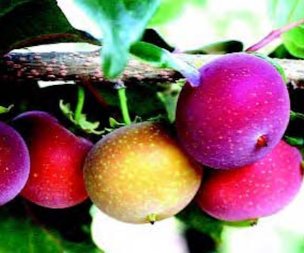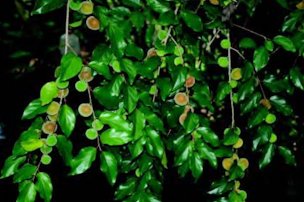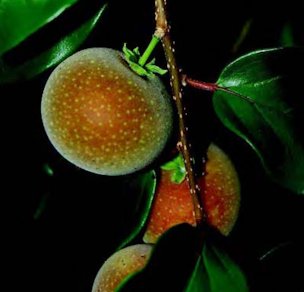From the Twelve
Fruits With Potential Value-Added and Culinary Uses
by Ken Love, Richard Bowen and Kent Fleming
Tropical Apricot
Scientific
name: Dovyalis hebecarpa x D. abyssinica
Family: Flacourtiaceae
Origin: Florida

Tropical apricot is a naturally occurring hybrid from Florida, developed in 1953 from a cross between kitembilla (Dovyalis hebecarpa) and Abyssinian gooseberry (Dovyalis abyssinica).
.
The
plant has many of the attributes of both parents. It is also known as
dovyah’s hybrid or just dovyalis. The name ketcot was proposed in 1960
but was not widely adopted, as the fruit never achieved the popularity
that was expected. The name tropical apricot, which has been used
to describe the fruit’s color and taste, is how the plant is commonly
referred to in the pan-tropical areas where it grows. The dovyalis
should not be confused with mamey (Mammea americana
L.), another fruit called tropical apricot or South American apricot.
Tropical apricot is a large shrub growing to more than 25 feet tall
with a width that matches its height. Its long branches are covered
with 2–4-inch, deep green leaves and often with thorns. The branches
bend downward, increasing the width of the plant, and are covered with
numerous male, female, and perfect flowers. The fruit is thin-skinned,
3 ⁄ 4 inch to almost 2 inches in diameter, turning from green to pale
yellow-orange to red when fully ripe. Yellow-orange fruits are
harvestable and will continue to ripen to red. The soft yellow-orange
flesh is usually sour, with a distinctive apricot-like flavor. Some
larger fruits contain one to five seeds, although most fruits are
seedless. Tropical apricot is a recent introduction to Hawai‘i,
although its parent, the kitembilla, (Dovyalis hebecarpa),
was brought to the islands in the early 1920s and was used as a
boundary plant to keep cattle out of sugarcane fields. Use of
kitembilla fruit, often mixed with papaya or mango, was popular for jam
and jelly.
Cultivars
Plants
are usually identified as sour and less sour, thorny or nearly
thornless. The thorns can be as long as 4–5 inches on mature trees.
Seedling shrubs are highly variable in thorniness, degree of sourness
of the fruit, and rate of growth. A cultivar, ‘Prodigal’, is available
in Florida and may be available in local nurseries.
Environment
The
tropical apricot is adapted to a wide range of soils and elevations
from 300 to 2500 feet, and it has been known to survive frost in
northern Florida. In deep soils with proper nutrition, the plants can
grow more than 3 feet per year in height and width. Seedlings tested in
South Kona showed significantly more growth in deeper soil (32 inches
of soil) than those planted in rocky areas (13 inches of soil). Mature
trees will produce some fruit year-round, with peak production in the
spring rainy season and a second moderately heavy crop in the fall.
Spacing of 15 feet is recommended for producing trees and 3–5 feet for hedgerows.
Horticulture
Plants
should be given a complete fertilizer, such as or ganic 6-6-6,
quarterly. Additional minor elements should be applied yearly or twice
yearly if the soil pH is above 6.7. Heavy mulching during the dry
season will help maintain the plants’ health and appearance.
Tropical apricot requires heavy pruning, especially if maintained as a barrier hedge.
Remove
branches with excessive thorns, dieback, or lateral growth to
facilitate harvesting. Thirty minutes of pruning per month was
sufficient for a 20-year old tree in South Kona. Mature plants do not
require as much in South Kona.
Mature plants do not require as much rainfall or irrigation once
established. Ten minutes of daily irrigation using a 1 ⁄ 4 -gallon/hour
emitter will in crease production during off-seasons. The plant will
fruit in full sun or partial shade. Most of the fruits form on outer
branches.

Immature fruit
Pests and diseases
No
diseases have been reported in the literature or observed on
producing trees in South Kona. The fruit is susceptible to fruit fly
infestation. Following the Hawai‘i Area-Wide Fruit Fly Pest Management
Program (HAW- FLYPM) is highly advisable, as is following good
sanitation practices, such as removing fallen and infected fruits.
Birds
occasionally enjoy the ripe fruits but are not a major problem.
Propagation
This
plant is easily propagated from cuttings or from air-layers, which will
fruit in the first or second year after planting. Seedlings are often
found under mature trees. Seedlings generally produce fruit in 3–4
years, but they tend to have more thorns than plants propagated from
cuttings or air-layers. Grafting the tropical apricot to a kitembilla
rootstock has been practiced in South Florida’s commercial nurseries.
Harvesting and yield
The
tropical apricot is a heavy producer. A 15-foot tall shrub can produce
more than 100 pounds of fruit per year. When harvesting for fresh
sales, it is advisable to place fruits directly in the vented container
in which it will be sold. Care should be taken to make sure the stem
end of the fruit is intact and the fruit is free of fruit fly
infestation, which usually appears as a soft spot. When harvested for
processing, the fruit should be processed as soon as possible after
harvest, as it attracts fruit flies and continues to decay.
Postharvest quality
Once
tropical apricot is harvested it should be kept chilled to prevent
decay. Tests at a South Kona grocery showed the fruit held its
appearance for 20 days on store shelves before signs of mold or
desiccation were visible.
Packaging, pricing, and marketing
Tropical
apricot can be packaged in 1 ⁄ 2 -pint or 1-pint vented plastic
containers for sale as fresh fruit in grocery stores and farm stands.
As most produce buyers are not familiar with the fruit, smaller
containers are advisable until the fruit gains a following at the
market.
Although the fruit has a thin skin, it holds well on
store shelves. Signs in stores promoting the fruit should reflect its
unique apricot-sour taste. Fresh fruits sold to hotel chefs and
restaurants can be packaged in larger containers, up to 5 pounds, but
fruits should not be packed in more than four or five layers in order
to protect the skin. Frozen puree can be packaged in 8-cup, or
smaller, freezer bags.
In 2005–06, fresh tropical apricot sold to
Big Island chefs for $3.50 a pound and was wholesaled to groceries at
$2.50 a pound. Frozen puree was sold for $40.00 per 8-cups.
Food uses and nutrition
The
fruit was a favorite of Big Island chefs and student chefs working with
the 12 Trees Project. It is easily frozen for future use, either as a
whole fruit or as processed puree. Chefs have created jelly, juice,
salad dressing, dipping sauce, hot sauce, BBQ sauce, pickles, chutney,
soup, wine, and brandy with this highly versatile fruit. The fruit is
said to have great potential for development of value-added products.
As fresh fruit, those who prefer a unique, sour taste enjoy it.
The
fruit can be processed into a puree using a home or commercial juicer.
Some chefs will process the fruit up to three times in a juicer.
Different consistencies of puree are achieved when the fruit is passed
though the juicer followed by the waste from the first pass.
Most
jelly made with tropical fruit is based on a 1 to 1 ratio of fruit to
sugar; however, with the sour tropical apricot, 60–70% sugar is usually
required to make the taste more palatable. The USDA guidelines for
producing jelly should be followed
.
Average degrees Brix
8–12 (five samples from each of two tropical apricot plants)

Mature fruit
Nutritional value per 100 g of edible portion of kitembilla*
| Moisture |
81.9–86.36 g |
| Protein |
0.174–1.5 g |
| Fat | 0.13–1.02 g | | Carbohydrate | 11.42 g |
| Crude Fiber |
1.3–1.9 g |
| Ash |
0.56–0.63 g |
| Calcium |
8–13.3 mg |
| Phosphorus |
12–26.8 mg |
| Iron |
0.45–1.41 mg |
| Carotene |
0.125–0.356 mg |
| Thiamine |
0.012–0.017 mg |
| Riboflavin |
0.033–0.051 mg |
| Niacin |
0.261–0.316 mg |
| Ascorbic
acid |
64.5–117 mg |
* No nutritive studies on the tropical apricot are available.
The values are compiled from various sources for the
kitembilla parent of tropical apricot.
Recipes
Tropical apricot red curry coconut sauce
Keola Tom
1 large can coconut milk
24 oz chicken or vegetable stock
3 cups tropical apricot juice
4 1 ⁄ 2 oz fish sauce (Patis or other brand)
6 oz red curry paste
(start with 3 oz, then adjust to taste)
3 cups sugar
Grated ginger to taste
Grated garlic to taste
Tamarind to taste
2 1 ⁄ 2 T paprika
Mature fruit
Combine
the first six ingredients and stir until sugar dissolves. Add the rest
of the ingredients and bring to a boil. Simmer 5–10 minutes, stirring
occasionally. More paprika can be added for color and to keep curry
from becoming too spicy. Yield: 5 quarts. Serve with wok-fired shrimp
and scallops.
Tropical apricot dipping sauce for spring rolls
Vince Mott
2 cups tropical apricot juice
50 ml (3 tablespoon + 1 teaspoon) peanut oil
2 dried chilies
3 scallions, white part with about 1 inch of green
left on, finely sliced
1 large knob ginger, finely diced
2 cloves garlic
15 ml (1 T) Chinese shaohsing wine
15 ml (1T) rice wine vinegar
2 T sea salt
2 T fine sugar
Mix ingredients well.
About
the Twelve Fruits
With Potential Value-Added and Culinary Uses Project
Back to
Tropical Apricot Page
|
© 2007, University of Hawai'i
|
Bibliography
Love, Ken, et al. "Twelve Fruits With Potential
Value-Added and Culinary
Uses." University of Hawai'i at Mānoa, College of
Tropical Agriculture and Human Resources, 2007, HawaiiFruit.net, www.hawaiifruit.net/12trees.html. Accessed 10 Apr. 2022.
Photographs
Love, Ken. "Tropical Apricot." Twelve
Fruits With Potential Value-Added and Culinary Uses, University of
Hawai'i at Mānoa, College of Tropical Agriculture and Human Resources,
2007, HawaiiFruit.net, www.hawaiifruit.net/12trees.html. Accessed 10 Apr. 2022.
Published 10 Apr. 2022 LR |


